Book Reviews
Book Reviews
AMERICAN SECRET PROJECTS 2 and 3
US Airlifters 1941 to 1961
By George Cox and Craig Kaston
Crécy Publishing, 1a Ringway Trading Estate, Shawdowmoss Road, Manchester M22 5LH, UK. 2019. 303pp. Illustrated. £27.50. ISBN 978-1-91080-916-7.
US Airlifters since 1962
By George Cox and Craig Kaston
Crécy Publishing, 1a Ringway Trading Estate, Shawdowmoss Road, Manchester M22 5LH, UK. 2020. 256pp. Illustrated. £27.50. ISBN 978-1-91080-933-4.
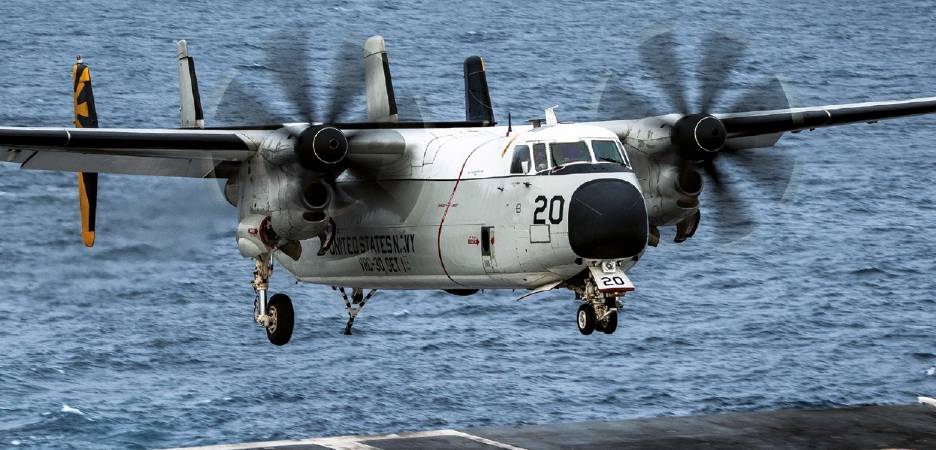 A C-2 Greyhound carrier on-board delivery aircraft from the Providers of Fleet Logistics Support Squadron (VRC) 30 prepares to make an arrested landing on the flight deck of the aircraft carrier USS Nimitz (CVN 68). US Navy.
A C-2 Greyhound carrier on-board delivery aircraft from the Providers of Fleet Logistics Support Squadron (VRC) 30 prepares to make an arrested landing on the flight deck of the aircraft carrier USS Nimitz (CVN 68). US Navy.
These two volumes (published by Crécy) complement Vol 1 of the series which dealt with fighters and bombers of WW2 and two previous publications by Midland which dealt with post-war combat aircraft.
The first volume begins with a brief history of US airlifters and then outlines the specific requirements of the genre, including the ability to load large heavy items onto a spacious cargo deck. While the requirement for substantial airlift capability first came to the fore during WW2 this was largely met by adapted civil designs, most famously the Douglas C-47, although the first purpose-designed projects did appear in prototype form. It was in this era when the requirement tended to divide into tactical and strategic, with the latter projects including influences from strategic bombers, as well as the burgeoning long-range civil market.
Some more exotic approaches were also attempted, such as flying wings and canard designs, which reappear several times during this story. Several other innovative approaches were also proposed, including swing tails and gull-wings to ease loading, turboprop and turbojet propulsion, as well as pod carriers, although none of these reached production.
The tactical requirement did result in a few successful designs, notably the Fairchild C-82, which were evolved over several iterations. However, by the mid-1950s, a competition between several manufacturers to provide a medium-lift capability resulted in the award of the contract to Lockheed for the C-130 Hercules. The strategic requirement followed a similar progression, with perhaps more effort to draw on civil designs, which resulted in the Douglas C-133, although longer-term success was minimal compared to the C-130.
During this period the requirement for a tanker/ transport to support SAC’s bombers also emerged but despite several optimised tanker proposals, budget and time constraints resulted in the Boeing KC-135, which drew heavily on cross-fertilisation with the civil B707. Moving on towards the 1960s saw many efforts to produce a better airlifter, by using as much as possible of civil designs, as well as going for more innovative solutions, resulting in the Lockheed C-141 which employed the same fuselage cross-section as the C-130. Other designs were aimed at producing greater lift, VTOL capability and even supersonic cruise.
The final chapter of Volume 2 deals with a number of proposals to meet the light airlifter needs of the US Army, which included adaptations of civil designs and fairly conventional new designs, as well as STOL and VTOL proposals.
These books display outstanding editorial standards, including many pictures and diagrams, many of which are attributable to the originating companies
Volume 3 continues with the attempts to produce a more effective strategic airlifter, capable of carrying outsized loads, while faced with budget constraints, which pushed constructors once again to draw on existing civil types and even for Boeing to propose a design utilising the wing of the B-52. However, it became clear that a new design would be required and a series of competitions and proposals followed, which eventually resulted in the Lockheed C-5.
At the other end of the scale the pursuit of a VTOL capability spawned a myriad of designs and proposals, including some unsolicited, which produced some prototypes but no production items, for the army support role or for the larger air force Hercules replacement. Efforts in the latter case were to continue, with emphasis moving away from VTOL to STOL and, after multiple proposals, resulted in a competition between prototypes of the Boeing YC-14, utilising the Coanda effect, and the Douglas YC-15 employing externally blown flaps.
However, a further change of emphasis saw resources being switched to strategic lift, which, after rejection of derivatives of the C-5 and the Boeing 747, eventually produced the McDonnell Douglas C-17, which is currently in service with the USAF and several foreign air forces. Meanwhile, efforts to modernise the tanker/transport fleet again saw the rejection of optimised designs in favour of the cheaper solutions of modifying a civil design, to produce the KC-10A and the upgrading and re-engining of the existing KC-135s.
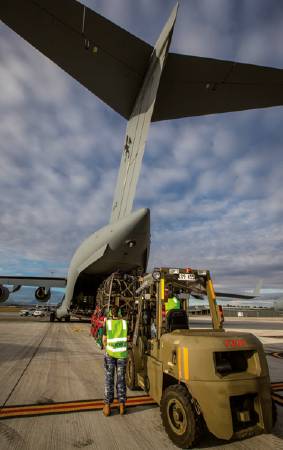 Royal Australian Air Force (RAAF) movements personnel from No 23 Squadron load a C-17A Globemaster prior to it departing RAAF Base Amberley to participate in Exercise Shaken Fury in the US. Commonwealth of Australia 2021.
Royal Australian Air Force (RAAF) movements personnel from No 23 Squadron load a C-17A Globemaster prior to it departing RAAF Base Amberley to participate in Exercise Shaken Fury in the US. Commonwealth of Australia 2021.
One of the longest chapters charts the history of Carrier On-board Delivery (COD), starting in the 1950s, involving a myriad of designs employing much of the V/STOVL techniques examined elsewhere but with an equal lack of success. Alternatives of adapting existing carrier-capable types and modifying civil designs, including the Boeing 727 and Fokker F-28, were also proposed over the decades but with only limited success.
The following chapter looks at proposals to use large airlifters as strategic missile launchers, the use of nuclear propulsion, span-loaders, pod carriers and other innovative approaches, that have yet to achieve success. Another chapter addresses the problem of out-sized loads, originating with the need to transport the large rocket boosters used in the US Moon programme. One of the proposals involved the use of the wings and other components of the British Saunders-Roe Princess flying boats, while another bizarrely employed two sets of wings and engines from Douglas DC-7s. Later efforts saw the use of a Boeing 747 to transport the Shuttle and of transport aircraft to launch rockets carrying satellites into orbit. The latter has had some success, including the launch of satellites from a Lockheed L1011 TriStar.
There is also a chapter that deals with the many projects based on the C-130 Hercules, including various test beds, stretched and wider fuselages, STOL variants with a selection of propulsion options, including rockets, and even a flying boat version. The final two chapters deal with the emerging airlift requirements and the technology likely to be available to meet them, although actually not that much has changed since the 1960s. The need for a special operations V/STOL capable airlifter, incorporating stealth features, has generated many proposals, without actually producing any hardware “at least as far as is known”.
These books display outstanding editorial standards, including many pictures and diagrams, many of which are attributable to the originating companies. There are also numerous tables of technical data, and performance information, although much of this is also contained in the text. Finally, both books are rounded off with a comprehensive glossary, a reference bibliography section and indexes.
All-in-all, the authors should be congratulated for completing what must have been a monumental task.
Colin Frazer
AMRAeS
SUKHOI Su-25
By Yefim Gordon and Dmitriy Komissarov
Crécy Publishing, 2020, 496pp, £44.95.
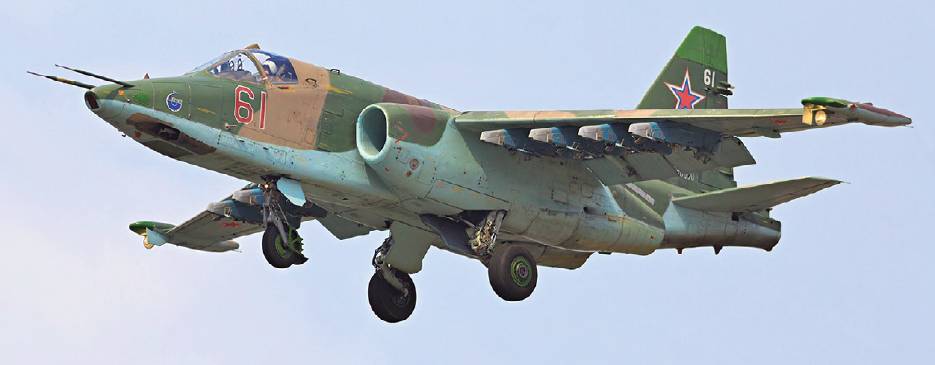 Sukhoi Su-25 of the Russian Air Force landing at Vladivostok. Leukhin Fedor.
Sukhoi Su-25 of the Russian Air Force landing at Vladivostok. Leukhin Fedor.
In 1970 the Soviet armed forces badly needed a modern ground attack aircraft to support their ground forces. Two of the famous Soviet design bureaux made proposals: The Ilyushin OKB with the Il-40 and the Sukhoi OKB with the Su-25. The Su-25 was chosen as the winner and made its first flight in 1972.
Following further development, the aircraft went into service in 1980 in support of the Soviet forces in Afghanistan, having been identified by NATO and given the reporting name ‘Frogfoot’. Subsequently the aircraft was also exported to a number of nations in Europe, Asia, Africa, South America and the Middle East, with more than 1,000 aircraft being produced. It has seen active service in a number of different theatres, including the recent Russian involvement in Syria, and is still in operational use today.
The book under review, which is the latest in the ‘Famous Russian Aircraft’ series, studies every aspect of the life of the Su-25 in great detail. Starting with a review of the competition, it then describes the testing and development of the aircraft, before giving a very detailed view of the aircraft structure and the wide variety of weapons that the aircraft is capable of carrying.
..as a ‘go to’ reference book on any aspect of the Su-25, it is unbeatable
Moving on, the book describes the aircraft’s involvement in various battlefield actions and then discusses its service with the various export customers. Finally, in a number of comprehensive appendices, the authors list the details of every single aircraft produced, together with the accident attrition data.
This is a ‘big’ book in every sense of the word. It has 500 pages, measures 29cm x 21cm x 4cm, and weighs 2.5kg! Despite this, it is a very readable book, which contains a lot of fascinating detail and more than 600 photographs and drawings. It is probably unlikely that anyone would sit down to read the book from cover to cover but, as a ‘go to’ reference book on any aspect of the Su-25, it is unbeatable.
Sir Donald Spiers
CEng HonFRAeS.
JOHN HOUBOLT
The Unsung Hero of the Apollo Moon Landings
By William F Causey
Purdue University Press, Stewart Center, 504 W. State Street, West Lafayette, IN 49707-2058, USA. 2020. xxiii; 347pp. Illustrated. $29.99. ISBN 978-1-55753-946-5.
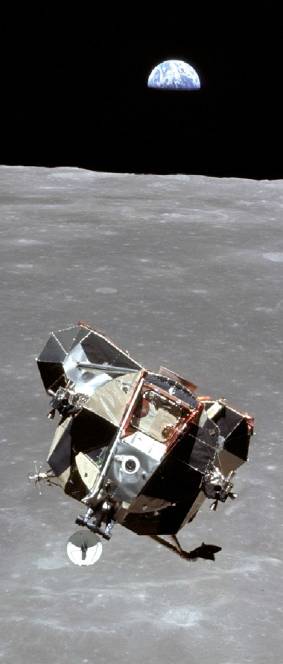 Earth, Moon and the ascent stage of the Lunar Excursion Module Eagle, in lunar orbit after return from the Moon and before rendezvous with the Apollo 11 Command Module Columbia. NASA.
Earth, Moon and the ascent stage of the Lunar Excursion Module Eagle, in lunar orbit after return from the Moon and before rendezvous with the Apollo 11 Command Module Columbia. NASA.
Have you ever watched an hour-long TV programme and thought to yourself that the story could have been told in half the time? That’s how I felt by the end of this story about one of the design decisions that led to the success of the Apollo Moon landings. NASA put together the first rough estimates of how much it would cost to put men on the Moon in 1959. There was not much detail behind the estimates but, in general terms, they assumed that a rocket would fly from the Earth direct to the Moon and then return – the concept popularised by Jules Verne in From the Earth to the Moon (1865) nearly a hundred years earlier. It was recognised that there might need to be a variation of that involving two or three launches from the Earth in order to assemble the giant Moon ship before leaving Earth orbit – a variation that was felt to be within the (very wide) error margins of the estimates.
The idea of assembling a Moon ship in orbit around the Earth was promoted by Wernher von Braun who, as head of NASA’s centre in Huntsville, Alabama, led the development of America’s largest rocket motors. Building on his experience with the V2 in Germany during WW2, he developed first the Jupiter C rocket that put America’s first satellite, Explorer 1, into orbit in 1958 and then got the go-ahead to develop a heavy-lift rocket that would eventually become the Saturn V used in the Apollo Moon missions. His vision was to have a space station orbiting the Earth that would be a factory for assembling spaceships bound for the Moon, Mars and beyond.
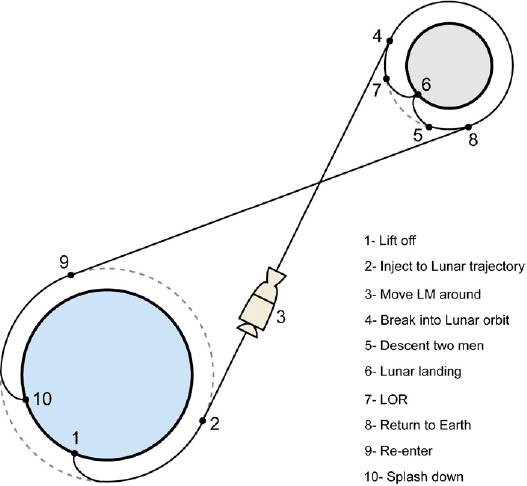 Lunar orbit rendezvous (LOR). Jooja.
Lunar orbit rendezvous (LOR). Jooja.
 A C-2 Greyhound carrier on-board delivery aircraft from the Providers of Fleet Logistics Support Squadron (VRC) 30 prepares to make an arrested landing on the flight deck of the aircraft carrier USS Nimitz (CVN 68). US Navy.
A C-2 Greyhound carrier on-board delivery aircraft from the Providers of Fleet Logistics Support Squadron (VRC) 30 prepares to make an arrested landing on the flight deck of the aircraft carrier USS Nimitz (CVN 68). US Navy. Royal Australian Air Force (RAAF) movements personnel from No 23 Squadron load a C-17A Globemaster prior to it departing RAAF Base Amberley to participate in Exercise Shaken Fury in the US. Commonwealth of Australia 2021.
Royal Australian Air Force (RAAF) movements personnel from No 23 Squadron load a C-17A Globemaster prior to it departing RAAF Base Amberley to participate in Exercise Shaken Fury in the US. Commonwealth of Australia 2021.

